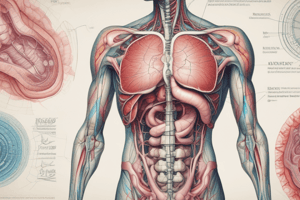Podcast
Questions and Answers
What is unique about the mucosal membrane in the rectal portion of the intestine?
What is unique about the mucosal membrane in the rectal portion of the intestine?
- It has folds (correct)
- It has villi
- It has a higher concentration of enteroendocrine cells
- It has a thicker layer of muscle
What is the likely reason for the richness of lymphoid cells and nodules in the lamina propria of the large intestine?
What is the likely reason for the richness of lymphoid cells and nodules in the lamina propria of the large intestine?
- The presence of a highly acidic environment
- The lack of mitosis in the epithelial cells of the large intestine
- The abundance of bacterial population in the large intestine (correct)
- The presence of a highly alkaline environment
What is the function of the intestinal glands in the large intestine?
What is the function of the intestinal glands in the large intestine?
- Absorption of nutrients
- Secretion of digestive enzymes
- Production of stomach acid
- Production of mucus and absorption of water (correct)
What is the process by which new epithelial cells are formed in the gastrointestinal tract?
What is the process by which new epithelial cells are formed in the gastrointestinal tract?
What is NOT a function of the large intestine?
What is NOT a function of the large intestine?
Study Notes
Intestine Structure
- The intestine (L.I.) consists of the appendix, cecum, colon (ascending, transverse, descending, and sigmoid), rectum, and anal canal.
Intestine Characteristics
- The mucosal membrane has no folds except in the rectal portion.
- No villi are present in the intestine.
Intestinal Glands
- Intestinal glands are long and contain many goblet and absorptive cells.
- Few enteroendocrine cells are present in the intestinal glands.
Intestine Functions
- Absorption of water.
- Formation of fecal mass.
- Production of mucus.
Lamina Propria
- Rich in lymphoid cells and nodules.
- Richness attributed to the abundant bacterial population of the L.I.
Renewal in the Gastrointestinal Tract
- Epithelial cells of the entire Gastrointestinal Tract are constantly being replaced.
- New cells are formed through mitosis of stem cells.
Studying That Suits You
Use AI to generate personalized quizzes and flashcards to suit your learning preferences.
Description
This quiz covers the anatomy and functions of the intestine, including its components, mucosal membrane, and glandular structure. It also discusses the absorption of water and the formation of fecal mass.



